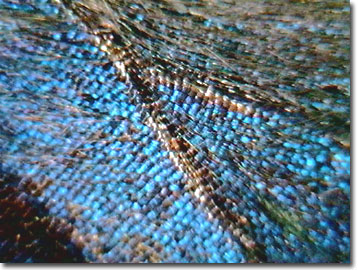Butterfly Wing Scale Digital Image Gallery
Dead Leaf Butterfly
Similar to many other insects that survive by looking like something they are not, the dead leaf butterfly is an exemplary mimic. The intricate disguise comes complete with a midrib, veins, and spots on the rough brown wing surfaces that provide the illusion of holes or areas of decay. The pupae, also deceptive, imitate curled up and further decayed brown leaves with the semblance of numerous moldy spots and a distinct, but withered, leaf stalk.

Dead leaf butterflies are scientifically described as Kallima paraletka and are members of the family Nymphalidae. As such, they feature a front pair of non-walking legs, which are highly modified and appear as brushes. The alternative common name of the species, Indian leaf, is a misnomer based on its collection by representatives of the East India Company, instead of the butterfly's actual country of origin. The name has led to some discrepancies about the butterfly’s native range, which is limited to Indonesia and Malaysia. Typical of many species in the area, the life cycle of the dead leaf butterfly centers on the monsoon and dry seasons.
At rest, mimetic perfection is reached as the dead leaf butterfly positions itself on a twig or branch in a pose that imitates nearby brown leaves before fall. Remarkably, the insects not only recognize their host plants and recreate the brown leaves in three dimensions, but also orient their bodies in a manner reflecting real leaves. However, when viewed from above in flight, the brown leaf costume gives way to wings boldly colored brown, bright orange, and regal blue. Males can be differentiated from females by the stronger blue tints on the upper surfaces of their hind wings.
The camouflage dead leaf butterflies display in their natural habitat helps protect them from individuals, but cannot protect them from society as a whole. Devastating deforestation of the Indo-Australian Region coupled with rampant population growth and chemical pollution assault the critical habitat of the relatively rare tropical species. As an insular species, the dead leaf butterfly is at even greater risk of extinction than its mainland congenerics. The species is often reared for butterfly conservatories, collected by butterfly enthusiasts, and used in educational displays.
Dead Leaf Butterfly Images in Reflected Light
Underside of Wing - The brown, tan, and black wing marking displayed in this image is part of the dead leaf butterfly's intricate disguise. The earth tone hues featured on the undersides of its wings help the lepidopteran disappear among surrounding foliage.
Contributing Authors
Cynthia D. Kelly, Shannon H. Neaves, Laurence D. Zuckerman, and Michael W. Davidson - National High Magnetic Field Laboratory, 1800 East Paul Dirac Dr., The Florida State University, Tallahassee, Florida, 32310.
BACK TO THE BUTTERFLY WING SCALE IMAGE GALLERY
BACK TO THE DIGITAL IMAGE GALLERIES
Questions or comments? Send us an email.
© 1995-2022 by Michael W. Davidson and The Florida State University. All Rights Reserved. No images, graphics, software, scripts, or applets may be reproduced or used in any manner without permission from the copyright holders. Use of this website means you agree to all of the Legal Terms and Conditions set forth by the owners.
This website is maintained by our
Graphics & Web Programming Team
in collaboration with Optical Microscopy at the
National High Magnetic Field Laboratory.
Last Modification Friday, Nov 13, 2015 at 02:19 PM
Access Count Since January 21, 2003: 31625
Visit the website of our partner in introductory microscopy education:
|
|
